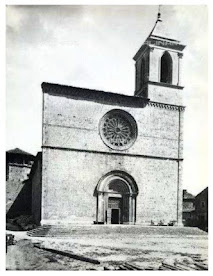For many years there has been considerable academic interest in the structural behaviour of masonry bell towers during earthquakes and whether their bells help or hinder performance. The observed level of interest is for the most part driven by the fact that masonry belfries are often amongst the structures most severely damaged when an earthquake strikes.
One such structure is the belfry at San Silvestro in L’Aquila Italy, which is pictured below as it was in 1906. It was damaged by an earthquake in 2009, however repair works continued until 2019. One of the difficulties of designing such repairs, or indeed pre-emptive strengthening, is the inherent difficulty of predicting how the structure will respond to the dynamic forces that seismic events generate. No two structures behave in the same way and therefore each one presents a fresh puzzle.
When a friend, and director of an MSc course in building conservation, recently passed me an academic paper with the somewhat catchy title ‘Identification and Model Update of the Dynamic Properties of the San Silvestro Belfry in L’Aquila and Estimation of Bell’s Dynamic Actions’, I read it with interest.
I confess that the mathematics contained in the paper are likely now beyond me. I am too far removed from doing analytical work in that depth.
That said, this is not always a bad thing as distance can sometimes bring perspective. In my view the most important diagnostic information in the paper is contained in figures 7a and 7b, because we can postulate from the depicted crack patterns what the complex mathematics mean.
That said everything that follows is complete speculation on my part. I have never visited the church, though I would like to, and I have no intimate knowledge of the way in which it was built. My entire speculation is based upon the reported pattern of cracking and some experience of designing buildings to resist earthquakes.
The base of the tower is locked to the ground and therefore travels back and forth at the same rate as the quake shakes the ground. Since the tower is not infinitely stiff it begins to flex when the ground and tower base start to move. The time taken to flex means that the lateral movement at the top of the tower lags behind the base of the tower. At some point the base of the tower, which was moving left starts to move right, but due to the effect of lag the top of the tower is still moving left. The top and bottom of the tower are now out of sync.
Thus, a snaking motion is set up in the tower, resulting in the crack pattern shown. It’s a bit like the wave you can generate in a skipping rope when you move the end up and down rapidly.
In mathematical terms we might say the period of the tower is greater than the period of the earthquake.
The maths in the paper essentially goes on to explain that the bell in the tower has no material effect on the period of the tower. This is because the bell’s mass, and hence momentum, is insufficient to overcome the stiffness and mass of the tower, even although the tower has flexed and cracked and movement at the top has lagged the base.
Unfortunately structures like this are not at all like modern ones in the sense that they don’t have clearly discernible load paths and consistent properties. It follows that academics will always find it difficult to determine the stiffness, and hence period, of a given tower with accuracy i.e. the analytical answer can only be as accurate as the estimation of stiffness. All the maths in the world doesn’t overcome that problem. It’s painstaking detective work that is required. In fairness I think the authors of the catchily titled paper acknowledge this difficulty.
I may well have over simplified the problem. For example, I haven’t mentioned the effect the rest of the church has, or what effect the windows in the bell tower have, or whether the tower’s stiffness changes over its height. In fact there are lots of things I haven’t mentioned. I am simply making an observation that the reported pattern of cracking is consistent with the explanation I have set out…… at least that's what I think. Feel free to differ.






No comments:
Post a Comment